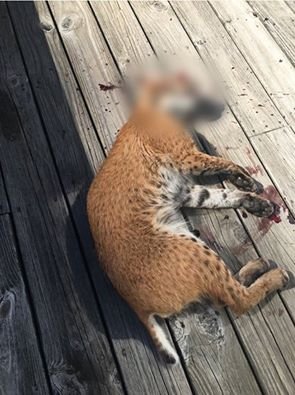DEC says rabid bobcat attack is rare
NEW SCOTLAND — A bobcat attack is being described as an out-of-the-ordinary event. The rabid animal attacked a couple and a dog last Wednesday.
The attack occurred on Rock Hill Road shortly after 4 p.m. last Wednesday, when the animal was shot and killed by the couple’s neighbor with a .22 caliber rifle, Chief Deputy Michael S. Monteleone with the Albany County Sheriff’s office told The Enterprise in an email. The Sheriff’s Deputies and Department of Environmental Conservation Officers responded to the scene, Monteleone said.
Although the names of the victims and the 911 caller have not been released, Rick Georgeson, a spokesman for the DEC, described them in an email as a couple and a dog. Monteleone says the couple was treated at St. Peter’s Hospital in Albany following the attack.
According to Mary Rozak, spokeswoman for the Albany County Executive’s office, the individuals began treatment on the day of the attack. The treatment involved a shot of human rabies immune globulin directly into any puncture wounds and a shot of a rabies vaccine to the arm. The vaccine shots are continued 3, 7, and 14 days after the first treatment.
According to Georgeson, the bobcat was taken to the DEC's Wildlife Health Unit at the Wildlife Resources Center in Delmar where a necropsy was performed Tuesday morning. The animal’s head was sent to the Wadsworth Laboratory in Guilderland where it was confirmed to have rabies.
The necropsy determined that the bobcat was a 22-pound adult male. It smelled of skunk spray and its face was covered in porcupine quills, according to Georgeson.
According to Monteleone, there are sporadic reports of suspected rabid animals in the county, but attacks are extremely rare.
A report from Wadsworth Laboratory says there have been 78 animals tested for rabies in the county from Jan. 1 to May 31 of this year, with 14 testing positive. Most of the animals received were bats but the majority of animals that tested positive were skunks.
Rozak advised people to follow safety guidelines to prevent getting rabies, particularly as the warmer weather leads to more outdoor activities.
“You need to be cautious and aware of your surroundings,” she said.
Rozak says behavior to look out for in determining if an animal has rabies is foaming at the mouth, hissing, and being out at the wrong time of day — for example an animal that is nocturnal being out during the afternoon.
“There are certain things that are really red flags,” she said.
If an animal with rabies is spotted, Rozak advises calling 911 if threatened or calling the local animal control department or the county health department if the situation is non-threatening. She advised that someone who has had contact with a potentially rabid animal should contact a physician or the county health department.
“While this isn’t an everyday occurrence we should all be aware and informed,” she said.
Georgeson stated that there have been 12 documented cases of rabid bobcats in the state since 1990, with five of those cases involving bites or scratches to humans. He also stated that conflicts between humans and bobcats are rare and mostly related to the animal preying on poultry or livestock, as the solitary animals typically avoid areas with a large amount of human development.
Georgeson described the big cats as ranging from 14 pounds for females to 21 pounds for males, although weight exceeding 30 pounds is possible. The animals feed primarily on small mammals but can take down an animal as large as the white-tailed deer.
Georgeson recommends homeowners be aware of pets or livestock kept outdoors: keeping small pets inside or supervised outdoors, and not feeding pets outdoors. He also stated that bobcats should never be approached, but instead observed from a distance.



